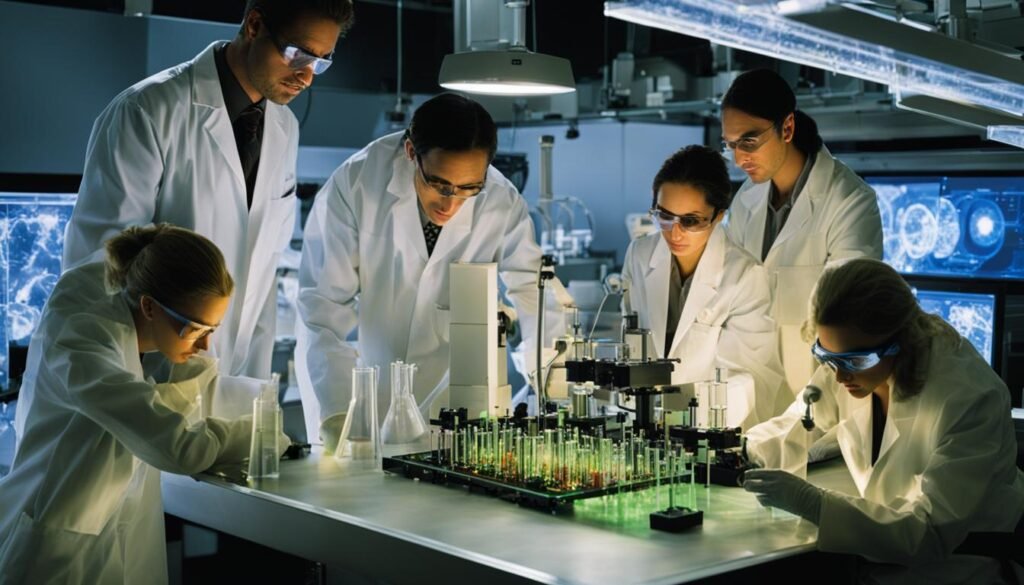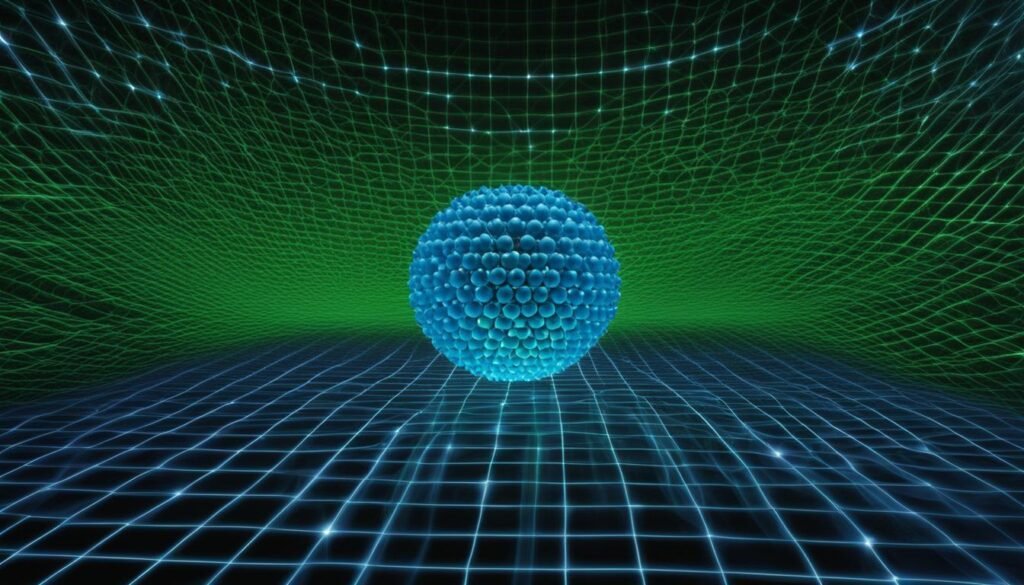Contents
Laser cooling of molecules is a groundbreaking technique that has transformed the field of atomic physics. This comprehensive guide will provide you with an in-depth understanding of the principles, techniques, and applications of laser cooling, as well as highlight future developments in the field.
Key Takeaways:
- Laser cooling allows for the trapping and cooling of particles to microkelvin temperatures.
- It has revolutionized various fields, including quantum degenerate gases, quantum information, atomic clocks, and fundamental physics tests.
- Different laser cooling techniques and experimental setups are used depending on the molecular species and cooling goals.
- Laser cooling of molecules has applications in ultracold chemistry, high-precision measurement, quantum simulation, and quantum computation.
- Ongoing research and developments in experimental techniques and theoretical understanding will continue to drive advancements in this field.
With this comprehensive guide, you will gain valuable insights into the fascinating world of laser cooling of molecules and its tremendous potential for scientific advancements and technological innovation.
Principles of Laser Cooling
Laser cooling is a fascinating technique that enables the trapping and cooling of particles to microkelvin temperatures. This method, originally developed for atoms, has also been successfully applied to molecules, expanding its range of applications. The principles of laser cooling revolve around the interaction between photons and particles, specifically the transfer of momentum that occurs when photons are absorbed and re-emitted by the particles.
The concept behind laser cooling is to use the momentum of photons to exert a force on the particles, slowing down their translational motion. By selectively exciting the particles with slightly detuned laser radiation, a net force opposing their motion is generated. This force, known as the radiation pressure force, acts in the opposite direction to the particles’ velocity and causes them to gradually lose energy and slow down.
To achieve laser cooling of molecules, various cooling techniques and experimental setups are employed. These techniques depend on the specific molecular species and the desired cooling goals. Doppler cooling is one commonly used method, in which the motion of particles is slowed down by the absorption and re-emission of photons. Another technique is magneto-optical trapping, in which magnetic fields and laser beams are used together to trap and cool particles. Additionally, anharmonic coupling of the motional degrees of freedom in the trap can enhance the cooling process.
In summary, laser cooling principles involve utilizing the momentum of photons to exert a force on particles, slowing down their motion. This technique can be extended to cool molecules as well, leading to the trapping and cooling of molecular samples at microkelvin temperatures. Different cooling techniques and experimental setups are employed based on the specific molecular species and desired cooling goals.
Techniques in Laser Cooling of Molecules

In the field of laser cooling, several techniques are employed to cool and control the motion of molecules, enabling experiments at ultracold temperatures. These techniques include Doppler cooling, magneto-optical trapping, and the use of anharmonic coupling. Each technique offers its own unique advantages and challenges, contributing to the comprehensive toolkit of laser cooling methods.
Doppler Cooling
Doppler cooling is a widely used technique in laser cooling that relies on the absorption and re-emission of photons to slow down the motion of particles. By shining laser radiation on a sample of molecules, the photons interact with the particles, imparting a force that opposes their motion. Through careful control of the laser frequency, the cooling process can be optimized to achieve efficient cooling. Doppler cooling is particularly effective for molecules with low Doppler temperatures and low saturation intensities.
Magneto-Optical Trapping
Magneto-optical trapping (MOT) combines magnetic fields and laser beams to trap and cool particles. In this technique, a combination of laser cooling and a magnetic field gradient is used to confine the molecules to a region of space called the trap. By adjusting the laser and magnetic field parameters, the sample of molecules can be cooled to ultracold temperatures. Magneto-optical trapping is a powerful technique for cooling a wide range of molecular species, including those with complex energy level structures.
Anharmonic Coupling
Anharmonic coupling involves exploiting the anharmonicity of the confining potential to enhance the cooling process. By carefully engineering the trap potential, the motional degrees of freedom of the molecules can be coupled, enabling more efficient cooling. This technique is particularly useful for molecules with low trap frequencies, where the traditional laser cooling methods may not be as effective. Anharmonic coupling can be implemented using a variety of trapping potentials, such as optical lattices or tightly focused laser beams.
| Laser Cooling Technique | Advantages | Challenges |
|---|---|---|
| Doppler Cooling | – Widely applicable to a range of molecular species – Relatively simple experimental setup |
– Limited cooling efficiency for molecules with high Doppler temperatures – Susceptible to optical saturation effects |
| Magneto-Optical Trapping | – Effective for cooling a wide range of molecular species – Enables long trapping times |
– Complex experimental setup – Challenges in achieving efficient cooling for molecules with complex energy level structures |
| Anharmonic Coupling | – Enhanced cooling efficiency for molecules with low trap frequencies – Flexibility in trap design |
– Requires careful engineering of the trap potential – Limited applicability to certain molecular species |
As researchers continue to advance the field of laser cooling of molecules, these techniques play a crucial role in enabling precise control and manipulation of molecular samples at ultracold temperatures. By harnessing the principles of Doppler cooling, magneto-optical trapping, and anharmonic coupling, scientists are pushing the boundaries of molecular physics and exploring new frontiers in areas such as ultracold chemistry, quantum simulation, and quantum computation.
Applications of Laser Cooling of Molecules

Laser cooling of molecules has opened up a plethora of applications in various scientific disciplines, contributing to advancements in ultracold chemistry, high-precision measurement, quantum simulation, and quantum computation.
Ultracold Chemistry
In the field of ultracold chemistry, laser cooling allows researchers to study chemical reactions at extremely low temperatures, offering insights into reaction dynamics and the formation of complex molecules. By manipulating the quantum states of ultracold molecules, scientists can investigate exotic chemical processes and explore new reaction pathways that are not feasible at higher temperatures.
High-Precision Measurement
The precise control and manipulation of laser-cooled molecules have revolutionized high-precision measurement techniques. By using laser-cooled molecules as sensors, researchers can accurately measure physical quantities such as time, electric and magnetic fields, and gravitational forces. This level of precision opens up opportunities for advancements in fundamental physics research, metrology, and the development of novel sensors for various applications.
Quantum Simulation and Computation
Laser-cooled molecules offer a platform for quantum simulation and quantum computation experiments. The controlled behavior of these ultracold molecules allows for the study of quantum phenomena, such as entanglement and superposition, and the development of quantum technologies. By engineering and manipulating the quantum states of laser-cooled molecules, scientists are paving the way for advancements in quantum information processing, quantum communication, and quantum simulation of complex systems.
| Applications | Description |
|---|---|
| Ultracold Chemistry | Allows for the study of chemical reactions at extremely low temperatures, providing insights into reaction dynamics and complex molecule formation. |
| High-Precision Measurement | Enables accurate measurements of physical quantities, including time, electric and magnetic fields, and gravitational forces, leading to advancements in fundamental physics research and metrology. |
| Quantum Simulation and Computation | Offers a platform for studying quantum phenomena and developing quantum technologies through the manipulation of laser-cooled molecules’ quantum states. |
With the continued progress in laser cooling techniques and the exploration of new molecular species, the applications of laser cooling of molecules are expected to expand further. These advancements hold promise for advancements in fields ranging from chemistry and physics to information technology and materials science.
Conclusion
Laser cooling of molecules has emerged as a groundbreaking technique in the realm of atomic and molecular physics. By harnessing the power of laser radiation, researchers are now able to trap and cool particles to microkelvin temperatures, revolutionizing our understanding of matter and its behavior at extreme conditions.
This comprehensive guide has explored the principles, techniques, and applications of laser cooling of molecules. By mastering the art of cooling particles through photon absorption and re-emission, researchers have unlocked opportunities for ultracold chemistry, high-precision measurements, and quantum simulation and computation experiments.
Looking ahead, the future of laser cooling of molecules holds great promise. As scientific advancements continue to unfold, further developments in experimental techniques and theoretical understanding will pave the way for groundbreaking discoveries and the creation of new technologies. The potential for even greater advancements in a multitude of scientific disciplines is within our grasp.
FAQ
What is laser cooling?
Laser cooling is a powerful technique that allows for the trapping and cooling of samples of particles to microkelvin temperatures using the momentum of photons to exert a force on atoms or particles.
How does laser cooling work?
Laser cooling works by selectively exciting atoms or molecules with slightly detuned laser radiation, generating a net force opposing their motion and slowing down their translational motion.
What techniques are used in laser cooling of molecules?
The techniques used in laser cooling of molecules include Doppler cooling, magneto-optical trapping, and anharmonic coupling of the motional degrees of freedom in the trap.
What are the applications of laser cooling of molecules?
Laser cooling of molecules has applications in ultracold chemistry, high-precision measurements and sensing, quantum simulation, and quantum computation.
What is the future of laser cooling of molecules?
Further developments in experimental techniques and theoretical understanding will be vital for advancing laser cooling of molecules and exploring its potential in various scientific disciplines and the development of new technologies.



